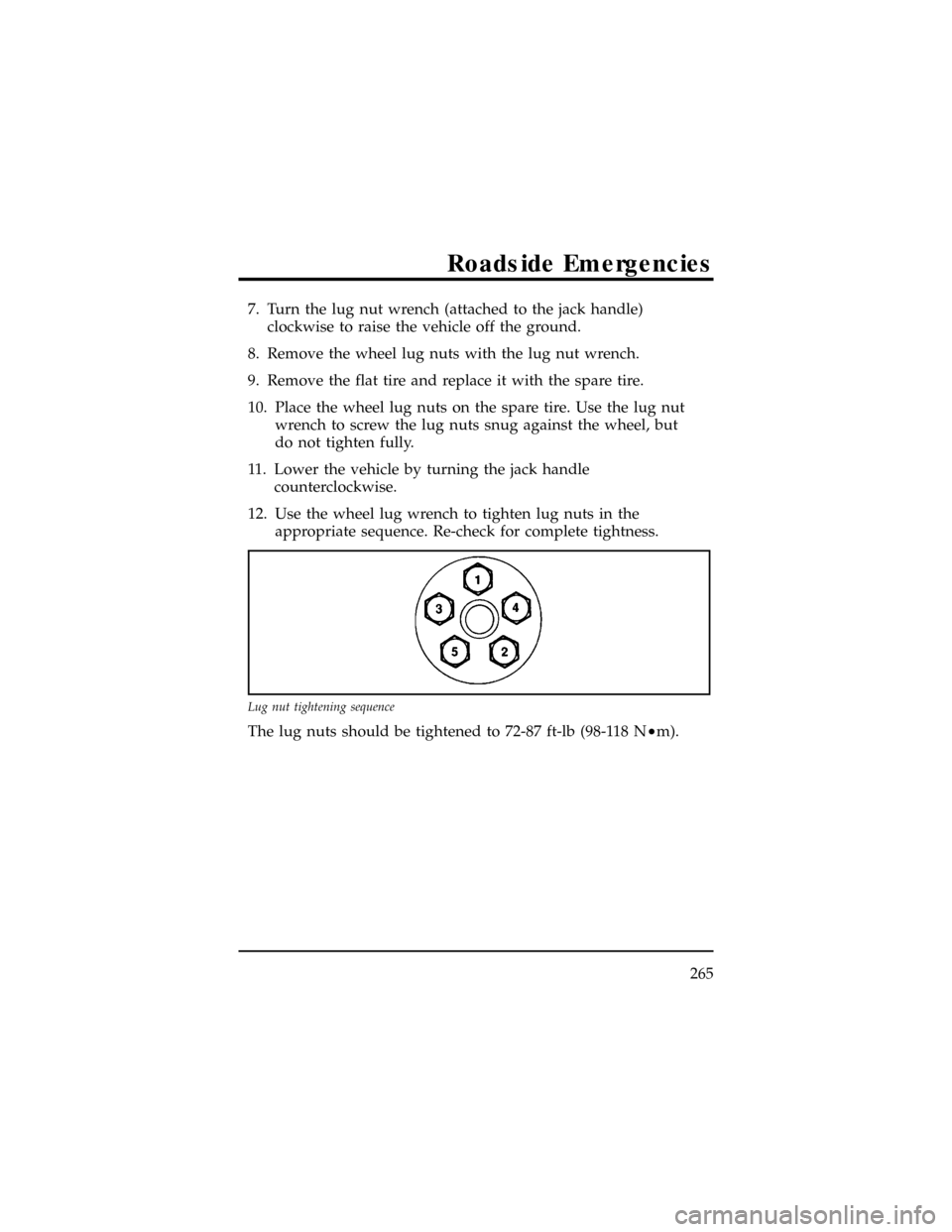clock Mercury Villager 1998 s User Guide
[x] Cancel search | Manufacturer: MERCURY, Model Year: 1998, Model line: Villager, Model: Mercury Villager 1998Pages: 400, PDF Size: 2.06 MB
Page 269 of 400

7. Turn the lug nut wrench (attached to the jack handle)
clockwise to raise the vehicle off the ground.
8. Remove the wheel lug nuts with the lug nut wrench.
9. Remove the flat tire and replace it with the spare tire.
10. Place the wheel lug nuts on the spare tire. Use the lug nut
wrench to screw the lug nuts snug against the wheel, but
do not tighten fully.
11. Lower the vehicle by turning the jack handle
counterclockwise.
12. Use the wheel lug wrench to tighten lug nuts in the
appropriate sequence. Re-check for complete tightness.
The lug nuts should be tightened to 72-87 ft-lb (98-118 N²m).
Lug nut tightening sequence
Roadside Emergencies
265
Page 291 of 400

Check the coolant level in the coolant recovery reservoir the next
few times you drive the vehicle. If necessary, add enough of a
50/50 mixture of coolant and water to bring the liquid level to the
fill line on the reservoir.
WARNING
Never remove the coolant recovery cap while the engine is
running or hot.
If you must remove the coolant recovery cap, follow these steps
to avoid personal injury caused by escaping steam or engine
coolant:
1. Before you remove the cap, turn the engine off and let it cool.
2. When the engine is cool, wrap a thick cloth around the
cap. Slowly turn cap counterclockwise to the first stop.
3. Step back while the pressure releases.
4. When you are sure that all the pressure has been released, use
the cloth to press the cap down, turn it counterclockwise, and
remove it.
Use Ford Premium Engine Coolant E2FZ-19549-AA (in Canada,
Motorcraft CXC-8-B) or an equivalent premium engine coolant that
meets Ford Specification ESE-M97B44-A. Ford Premium Engine
Coolant is an optimized formula that will protect all metals and
rubber elastomers used in Ford cooling systems for 4 years or
50,000 miles (80,000 km).
Do not use alcohol or methanol antifreeze or any engine coolants
mixed with alcohol or methanol antifreeze. Do not use
supplemental coolant additives in your vehicle. These additives
may harm your engine cooling system.The use of an improper coolant
may void the warranty of your vehicle's engine cooling system.
Maintenance and Care
287
Page 310 of 400

mDrive slowly. If you can hear the cables rub or bang against
your vehicle, stop the vehicle and tighten the cables. If you
continue to hear the cables rub or bang against your vehicle,
remove the cables to prevent damage to your vehicle.
mAvoid fully loading your vehicle if possible.
mRemove tire cables at the first opportunity after using them on
snow and ice. Do not use the cables on dry roads.
Make sure your suspension insulators and bumpers are not
missing or worn to avoid damage to your vehicle.
Filling the Fuel Tank
Removing the tethered fuel filler cap
1. Open the fuel door on the driver's side of the vehicle.
2. Slowly unscrew the cap counterclockwise, using caution to
minimize the possibility of fuel spraying.
If the Service Engine Soon warning light comes on and stays
on when you start the engine, the fuel cap may not be properly
seated. Turn off the engine, remove the fuel cap and replace it, being
careful to align the cap properly.
The tethered fuel filler cap
306
Page 312 of 400

Before you fill your vehicle with fuel, extinguish all lit cigarettes,
other smoking materials, and any open flames.
To fill the tank properly:
1. Remove the fuel filler cap. Proceed to add fuel to the tank
only if your vehicle is on level ground.
2. Make sure you pump unleaded fuel and put the nozzle all the
way inside the fuel filler pipe. The fuel tank is normally full
after three automatic shutoffs of the nozzle.
3. If you spill any fuel on the body of your vehicle, clean it off
immediately. The fuel may dull or soften the paint if you do
not wash it off.
4. Replace the fuel cap tightly when you are finished. Turn it
clockwise until you hear at least three clicks. The
ratcheting mechanism allows the fuel cap to be sealed without
overtightening.
5. Push the fuel door closed.
Choosing the Right Fuel
Use only UNLEADED FUEL. The use of leaded fuel is prohibited
by law and could damage your vehicle. The damage may not
be covered by your warranty.
Your vehicle was not designed to use fuel containing
manganese-based additives such as MMT. Additionally, vehicles
certified to California emission standards (indicated on the
underhood Vehicle Emissions Control Information label) are
designed to operate on California reformulated gasolines. If
California reformulated gasoline is not available when you refuel,
your vehicle can be operated on non-California fuels. However,
even though your engine will perform adequately on other
308
Page 322 of 400

3. Remove the bulb retaining ring by turning it counterclockwise
1/8 of a turn to free it from the socket. Then slide the ring off
the plastic base.Keep the ring.You must use it again to
hold the new bulb in place.
4. Carefully remove the bulb assembly from its socket by
gently pulling it rearward without turning.
5. Do not touch the bulb with your skin or you could shatter the
bulb. Always grasp the bulb assembly from the plastic base.
6. Be sure that you have the proper replacement bulb ready before
you discard the burned out bulb.
Removing the headlamp bulb retaining ring
318
Page 380 of 400

Chime
headlamps on.......................18
safety belt.........................11
Circuit breakers
checking and replacing..................252
see also fuses......................243
Cleaning your vehicle....................329
chrome and aluminum parts...............330
engine compartment...................331
exterior.........................329
exterior lamps......................330
fabric..........................332
headlamps........................330
instrument panel.....................330
instrument panel lens..................332
interior..........................332
plastic parts.......................330
polishing.........................329
rustproofing.......................330
safety belts........................332
tail lamps........................330
upholstery and interior trim...............332
washing.........................329
waxing..........................329
wheels..........................330
Climate control system
air conditioning......................56
heating..........................56
Clock............................40
Clutch
fluid reservoir......................282
Cold engine starting....................208
Combination lap and shoulder belts..........129, 131
376